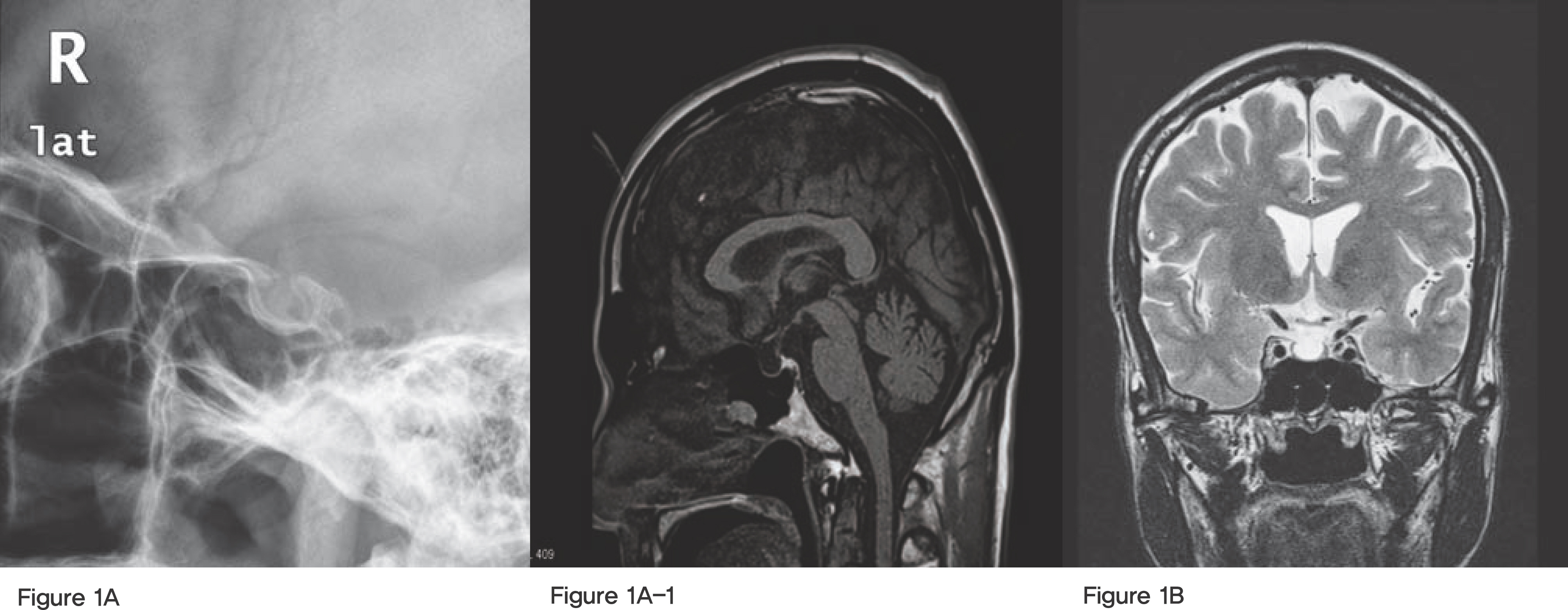Kosin Med J.
2014 Dec;29(2):151-155. 10.7180/kmj.2014.29.2.151.
A Case with Empty Sella Syndrome Combined with Multiple Anterior Pituitary Hormone Deficiencies Presenting as Hypoglycemic Coma
- Affiliations
-
- 1Department of Internal Medicine, Gyeongsang National University, Jinju, Korea.
- 2Institute of Health Sciences, Gyeongsang National University, Jinju, Korea.
- KMID: 2308501
- DOI: http://doi.org/10.7180/kmj.2014.29.2.151
Abstract
- A 55-year-old male was admitted to emergency department with a hypoglycemic shock of unknown origin. He was presented with tonic seizure activity after admission. Initial diagnostic procedure could exclude diabetes mellitus, drug side effects, and exogenous insulin application. Detailed evaluation of the patient's history revealed that the patient had experienced repeated hypoglycemic episodes for 2 years. He was diagnosed with hypothyroidism six years ago. Initial laboratory investigations revealed hypoglycemia, hyponatremia, and low plasma cortisol level (0.18 microg/dL). Sellar magnetic resonance imaging showed empty sella. Replacement therapy with hydrocortisone resulted in the improvement of clinical symptoms. Combined pituitary stimulation test with exception of hypoglycemia induced growth hormone and cortisol stimulation test was performed. The response of thyroid stimulating hormone, prolactin, follicle-stimulating hormone, and luteinizing hormone was normal. We report the case of empty sella syndrome associated with hypoglycemic shock due to with multiple anterior pituitary hormone deficiencies.
Keyword
MeSH Terms
-
Coma*
Diabetes Mellitus
Emergency Service, Hospital
Empty Sella Syndrome*
Follicle Stimulating Hormone
Growth Hormone
Humans
Hydrocortisone
Hypoglycemia
Hyponatremia
Hypothyroidism
Insulin
Luteinizing Hormone
Magnetic Resonance Imaging
Male
Middle Aged
Plasma
Prolactin
Seizures
Shock
Thyrotropin
Follicle Stimulating Hormone
Growth Hormone
Hydrocortisone
Insulin
Luteinizing Hormone
Prolactin
Thyrotropin
Figure
Reference
-
1.Busch W. Morphology of sella turcica and its relation to the pituitary gland. Virchows Arch. 1951. 320:437–58.2.Brisman R., Hughes JE., Holub DA. Endocrine function in nineteen patients with empty sella syndrome. J Clin Endocrinol Metab. 1972. 34:570–3.
Article3.Neelon FA., Goree JA., Lebovitz HE. The primary empty sella: Clinical and radiographic characteristics and endocrine function. Medicine. 1973. 52:73–92.4.Caplan RH., Dobben GD. Endocrine studies in patients with the “empty sella syndrome”. Arch Intern Med. 1969. 123:611–9.
Article5.Gallardo E., Schachter D., Caceres E., Becker P., Colin E., Marta nez C, et al. The empty sella: results of treatment in 76 successive cases and high frequency of endocrine and neurological disturbances. Clin Endocrinol. 1992. 37:529–33.
Article6.Oh EY., Kim BJ., Chung YJ., Kim DJ., Hahm JR., Chung JH, et al. Clinical and hormonal analysis of five new cases and eight previously reported cases of isolated ACTH deficiency in Korea. J Korean Soc Endocrinol. 1999. 14:568–77.7.Choi JH., Park BH., Jo CG. Isolated adrenocorticotropic hormone deficiency associated with empty sella syndrome. Korean J Med. 2008. 75:597–601.8.De Marinis L., Bonadonna S., Bianchi A., Maira G., Giustina A. Primary empty sella. J Clin Endocrinol Metab. 2005. 90:5471–7.
Article9.Gallardo E., Scha chter D., Caceres E., Becker P., Colin E., Marta nez C, et al. The empty sella: results of treatment in 76 successive cases and high frequency of endocrine and neurological disturbances. Clin Endocrinol. 1992. 37:529–33.
Article10.Hatazoe T., Murakami Y., Umaki I., Sohmiya M., Hu HY., Kato Y. Isolated adrenocorticotropic hormone deficiency associated with growth hormone deficiency and empty sella. Intern Med. 1995. 34:688–91.
Article11.Murakami T., Wada S., Katayama Y., Nemoto Y., Kugai N., Nakata N. Thyroid dysfunction in isolated adrenocorticotropic hormone (ACTH) deficiency: case report and literature review. Endocr J. 1993. 40:473–8.
Article12.Spencer CA., Schwarzbein D., Guttler RB., LoPresti JS., Nicoloff JT. Thyrotropin (TSH)-releasing hormone stimulation test responses employing third and fourth generation TSH assays. J Clin Endocrinol Metab. 1993. 76:494–8.
Article
- Full Text Links
- Actions
-
Cited
- CITED
-
- Close
- Share
- Similar articles
-
- A case of primary empty sella syndrome combined with Cushing's disease
- Two Cases of Graves Disease Associated The Empty Sella Syndrome
- A Case of Primary Empty Sella Syndrome with Central Diabetes Insipidus
- A Case of Cushing's Disease due to Pituitary Microadenoma Combined with Primary Empty Sella Syndrome
- A Case of Parathyroid Adenoma Presenting as Acute Pancreatitis Accompanied with Empty Sella


